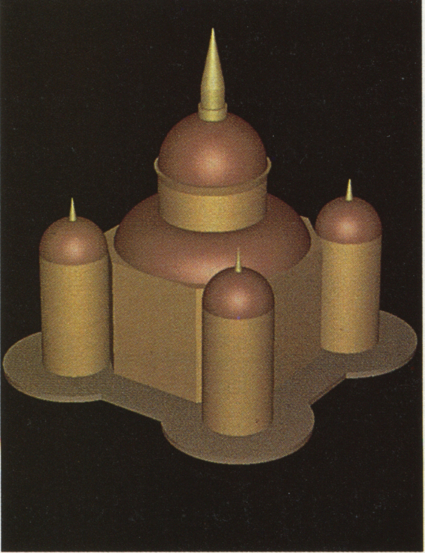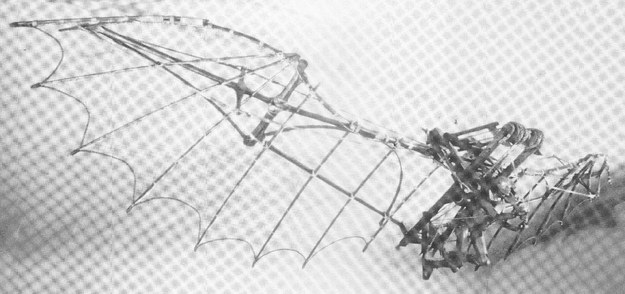Very probably the most widely seen video animation on the London art scene this year will be the scientific graphics on show at the Leonardo da Vinci exhibition at the Hayward gallery this spring. The full title of the show is Leonardo da Vinci: artist scientist - inventor, sponsored by the ibm corporation and attracting vast crowds of the general public . Cynical art world observers might condemn such exercises in the controlled dissemination of high culture, but on closer inspection this is not just the profitable fostering of art-religion. After the appropriation of the alienated Chaplin figure for the caring face of a huge multinational information technology mogul, the aura of Leonardo - the renaissance universal man - allows the construction of a powerful context in which to present the ambitions of industrial scientists in acceptable cultural form. Leonardo's work is presented here as a coherent body of visual research into the natural world from which morphological laws are derived , and used to suggest the indebtedness of great art to scientific methodology. But as scientific research is increasingly conducted in terms of computer imagery the reality of that methodology is changed and its authority usurped by the imperialism of the image.
As well as a selection of 130 drawings from Leonardo's sketchbooks there are also no less than five separate animated sequences continually showing, modelled and animated by computers at an ibm labaratory, and seeking to demonstrate a correspondence between Leonardo's various studies of lighting effects, perspective and geometry and the current state of computer graphics research. Thirteen of Leonardo's engineering designs have been converted into working models and the show reaches its climax in his design for man-powered flight, especially recreated in unnaturally aged timber and old rope, suspended from the ceiling as well as animated on video in the last gallery enclosure before the souvenir stalls begin.
The exhibition catalogue contains a preface by that crusty old scholar of illusionist art e.h. Gombrich, in which he reminds (warns) us that to Leonardo the widespread ignorance of the fundamental truth, that there was no art without science, was responsible for the low esteem in which his chosen profession was too often held.
But what can be the contemporary relevance of the above remark, when, as science constantly seeks to enlarge the domain of its influence, so art world interests conspire to exclude it by the hazy barriers of individualism and subjectivity. But we need not reproach corporate science for its attempt via the soft underbelly of Leonardo's oeuvre to create a context in which it can subsume visual culture, for in its eagerness to exploit computer graphics tom present scientific knowledge as media spectacle, it compromises its epistemological basis in a very real sense and is made ripe to become the latest and most humbled victim of the video culture.
Leonardo's observational studies taken apart, we might be faced by an apparent concern by the organisers merely to show us how the investigation of anatomical structure and mechanical engineering has progressed over the past 500 years to the point where the work of a medieval amateur scientist can only be viewed as a quaintly heroic if somewhat naive struggle with problems he was necessarily illequipped to master. The concomitant status of Leonardo as a great renaissance artist is certainly not excluded from this show (the Hayward in an art gallery after all), but the effect of presenting his allegorical and religious drawings in this context is to resurrect the idea of art as the evolution of visual knowledge and its culmination in the achievements of computer generated imagery.
As the catalogue informs us, Leonardo's programme of visual research was an empiricist one - nothing less than the acquisition of knowledge of the world through sensory experience, specifically the medium of sight. (from the copious sketchbooks that he kept we are compelled to conclude that the realisation of this knowledge was in the drawings he created, rather than the body of abstract and idealised structures he derived from them, which, in Leonardo's case were frequently prone to mathematical and other technical errors anyway).
In fact one should say that Leonardo's scientific achievement stopped far short of even an empiricist's reluctant duty to abstract general laws as the necessary fictions that constitute theoretical knowledge. Leonardo's work could better be read as constituting knowledge from drawing as simulation rather than knowledge from a subsequent analysis of the drawing as diagram. In keeping with medieval natural philosophy Leonardo could see his artistic perception as a form of scientific knowledge, an analogical knowledge, of the visually instead of the linguistically metaphorical.
The recent application of computer graphics to much scientific research is to visualise the dynamics of a mathematical object, possibly representing some physical process, as a graphic entity - such as the study of the water or air currents undergoing turbulent behaviour that so fascinated Leonardo in his vortex studies. The amount of data generated in these computational runs are immense and totally opaque to traditional analysis, and to represent them as imagery and animations are often the only way to gain an initial insight into the forces under investigation. But these images are not like the simple diagrams of mathematical functions that we used in our school textbooks to focus our attention on some trigonometrical teaser. These images are fluid and continuous like a photograph, they do not offer the viewer a straightforward lexicography of signs and symbols from which specific elements can be made to correspond to specific causes - for their interpretation they shift towards the domain of a semiology rather than linguistic analysis.
Although Leonardo's drawings as scientific illustrations remain objective in method, his art was not realist in the artistic sense, not concerned with the bourgeois domesticity of van eyck or the dramatics of caravaggio - Leonardo's work inherited its aspirations from the traditions of greek idealism, but mutated by his rampant imagination. Most of Leonardo's larger scale works, finished and unfinished, contain elements of the fantastic - surreal landscapes, grotesque character, incongruous groups of figures placed near to the main subject. His contrived mannequin-like figures straddle the boundary between rational idealism and the extreme at which it turns into a kind of magic realism, more reminiscent of Botticelli than Massacio. The designs for axle bearings, differential gear systems and armoured cars were far from the standards needed for feasible engineering drawings, and their reconstruction for this exhibition involved much improvisation on the part of the companies commissioned to build them, giving the final models more of the status of sculptures in the manner of tinguely rather than Gabo. Leonardo's formal structures become a foil against which to playoff his poetic associations.
In the field of scientific visualisation the dilemma of the realist epistemology is becoming ever more acute. Mathematical functions are tending to be seen in terms of the imagery they generate rather than subsuming them. The representational stance of the diagram is being replaced by the creation of images with sufficient visual integrity to allow a referential dislocation from their notational expression. Just as music is not constituted on the stave of a manuscript, so mathematical and scientific visualisations are assuming a status as real objects greater than the conceptual and ideal objects embodied in the formal string of symbols they are derived from.
The main feature of late twentieth century scientific method is an erosion of the metaphysics of theoretical knowledge by the commercial demands of lyotardian performativity and now accelerated by the powerful formalisms of the computer, able to generate mathematical models simply by exhaustive trial and error search, producing an unsettling behavioural definition of mathematical knowledge. Computer science and visualisation techniques are providing the impetus for an allegorical knowledge founded in a kind of mathematical poetry, but the animations at the Leonardo exhibition reveal only the thinnest end of this very considerable wedge. At this time scientific videographics is still at its easel-painting stage, with rambling data structures and abstruse mathematical functions being subjected for the most part to predetermined visualisation schemes, reinforcing the hierarchy of model/graphics and tending to produce a closed text, a methodology that Leonardo's perverse idealism unwittingly subverts. With more computer power continually being pumped into electronic visualisation we will see in future a shift from the theoretical model carrying the burden of knowledge to it being but a codified shorthand in the ascendancy of image-based science.

